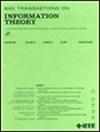The b-Symbol Hamming Weight Spectra of Quaternary Kerdock Codes and Related Codes
IF 2.9
3区 计算机科学
Q3 COMPUTER SCIENCE, INFORMATION SYSTEMS
引用次数: 0
Abstract
The symbol-pair coding theory was put forward by Cassuto and Blaum [IEEE TIT, 2011] to be applicable in high-density storage situations. Yaakobi et al. [IEEE TIT, 2016] extended the concept of symbol-pair metric to四元Kerdock码及相关码的b符号Hamming权谱
符号对编码理论由Cassuto和Blaum [IEEE TIT, 2011]提出,适用于高密度存储环境。Yaakobi等人[IEEE TIT, 2016]在$b\geq 2$时将符号对度量的概念扩展到b-符号度量。关于循环码的b符号汉明权谱的广泛研究主要集中在字母是有限域的情况下。${\mathbb {Z}}_{4}$上的循环码是一类极其重要的码,但长期以来在研究b符号汉明权谱时却被忽视了。本文研究了缩短Kerdock码${\mathcal {K}}_{m}^{-}$和${\mathcal {K}}_{m}$ over ${\mathbb {Z}}_{4}$的Kerdock码的b符号Hamming权谱。给出了${\mathcal {K}}_{m}^{-}$和${\mathcal {K}}_{m}$中码字的符号对汉明权值的计算公式,其值取决于teichmller集合中特定元素的类迹函数值。特别地,我们给出了一类具有三个非零b符号汉明权值的${\mathbb {Z}}_{4}$ -循环码。作为副产物,给出了Preparata码和Goethals码的b符号汉明权重层次。
本文章由计算机程序翻译,如有差异,请以英文原文为准。
求助全文
约1分钟内获得全文
求助全文
来源期刊

IEEE Transactions on Information Theory
工程技术-工程:电子与电气
CiteScore
5.70
自引率
20.00%
发文量
514
审稿时长
12 months
期刊介绍:
The IEEE Transactions on Information Theory is a journal that publishes theoretical and experimental papers concerned with the transmission, processing, and utilization of information. The boundaries of acceptable subject matter are intentionally not sharply delimited. Rather, it is hoped that as the focus of research activity changes, a flexible policy will permit this Transactions to follow suit. Current appropriate topics are best reflected by recent Tables of Contents; they are summarized in the titles of editorial areas that appear on the inside front cover.
 求助内容:
求助内容: 应助结果提醒方式:
应助结果提醒方式:


